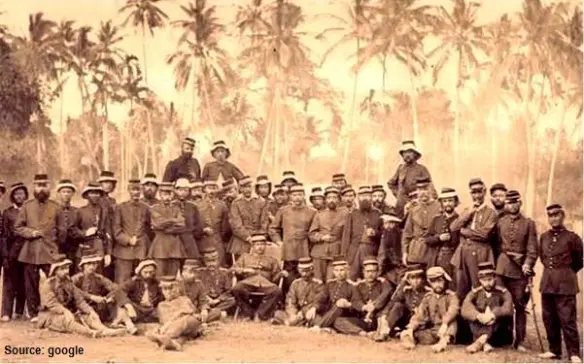Back in the late 1800s, Sisingamangaraja XII wasn’t messing around. He went head-to-head with the Dutch, giving them a run for their money in 1878. Why? Well, he couldn’t stand those European missionaries poking around and decided to take a bold stance. The missionaries got all rattled up and spilled the beans to the Dutch colonial government about the rebellion going on in Negeri Toba.
As you’d expect, the colonial bigwigs had the missionaries’ backs. They didn’t just target Sisingamangaraja XII’s HQ; they aimed for the whole Tanah Toba region. Come February 1878, the Dutch brought in their troops, teaming up with the missionaries deep in the wilds of North Sumatra.
They cooked up a plan to hit Sisingamangaraja XII, but he was ready for them. On February 18, 1878, the Raja of Tanah Toba declared war against those foreign intruders. Kicking out the evangelists raised eyebrows about Sisingamangaraja XII’s religious gig.
What Did Sisingamangaraja XII Believe In?
Before Islam and Christianity got their groove on in the Batak hood, the locals were all about ancestral vibes—animism, or as the Batak crew called it, Ugamo Batak. Different villages had different flavors, like Parbegu.
But here’s the twist—besides Parbegu, most Batak peeps were into Malim. They called themselves Parmalim. This Malim gig was like a mashup of Islam, Christianity, and some local traditions. For some, it was a response to the social and political scene in their neck of the woods.
Bonar W. Sidjabat, throwing down in “Ahu Sisingamangaraja,” swears Sisingamangaraja XII was repping the Malim belief. Meanwhile, the dynamic duo S.P Napitupulu & Hilderia Sitanggang in “Arsitektur Tradisional Daerah Sumatera Utara” agreed, tagging him as Parmalim, a Malim devotee.
Did Sisingamangaraja XII Flip to Islam?
Hold up, there’s a theory floating around that Sisingamangaraja XII might’ve taken a Muslim turn. Check it—Negeri Toba, under Sisingamangaraja XII, used to be ruled by the Islamic Sultanate of Paguruyung, hailing from West Sumatra’s Minangkabau turf. Thomas Stamford Raffles, the bigwig Governor-General of the Dutch East Indies in the early 1800s, spilled the tea that Sisingamangaraja XII had Minangkabau roots.
This connection to Paguruyung, which started as a Hindu gig and later went full Islam, makes folks think Negeri Toba rolled with the same faith. Some even say Sisingamangaraja XII might’ve caught the Islam bug during his dad’s military stint in Aceh, as the story goes by Dada Meuraxa.
The Guy Who Shook Up Batak Politics
Even though Sisingamangaraja XII bit the dust in a showdown with the Dutch on June 17, 1907, the talk about his religious flavor keeps buzzing. People are still scratching their heads about his connections to Muslim-heavy Aceh and his powwows with the famous German Batak Christian, Nommensen.
Ulo Kozok, the German scholar digging into traditional Batak texts, is dropping truth bombs. He’s saying Sisingamangaraja XII wasn’t vibing with Malim, Islam, or Christianity. According to Kozok, when Malim was rising in Tanah Batak, he was already chilling in Dairi, dodging the colonial squad. Malim was a newbie belief back then, not on the level of Islam or Christianity.
In a nutshell, regardless of his spiritual flavor, Sisingamangaraja XII deserves a salute in Batak history, especially up in North Sumatra. He was a leader who kept it real, open to rocking new political vibes from beyond Tanah Batak to break free from the old-school politics when the times were changing.



